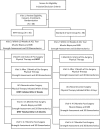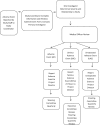Effect of Blood Flow Restriction Training on Quadriceps Muscle Strength, Morphology, Physiology, and Knee Biomechanics Before and After Anterior Cruciate Ligament Reconstruction: Protocol for a Randomized Clinical Trial
- PMID: 30951598
- PMCID: PMC6665950
- DOI: 10.1093/ptj/pzz062
Effect of Blood Flow Restriction Training on Quadriceps Muscle Strength, Morphology, Physiology, and Knee Biomechanics Before and After Anterior Cruciate Ligament Reconstruction: Protocol for a Randomized Clinical Trial
Abstract
Background: Despite best practice, quadriceps strength deficits often persist for years after anterior cruciate ligament reconstruction. Blood flow restriction training (BFRT) is a possible new intervention that applies a pressurized cuff to the proximal thigh that partially occludes blood flow as the patient exercises, which enables patients to train at reduced loads. This training is believed to result in the same benefits as if the patients were training under high loads.
Objective: The objective is to evaluate the effect of BFRT on quadriceps strength and knee biomechanics and to identify the potential mechanism(s) of action of BFRT at the cellular and morphological levels of the quadriceps.
Design: This will be a randomized, double-blind, placebo-controlled clinical trial.
Setting: The study will take place at the University of Kentucky and University of Texas Medical Branch.
Participants: Sixty participants between the ages of 15 to 40 years with an ACL tear will be included.
Intervention: Participants will be randomly assigned to (1) physical therapy plus active BFRT (BFRT group) or (2) physical therapy plus placebo BFRT (standard of care group). Presurgical BFRT will involve sessions 3 times per week for 4 weeks, and postsurgical BFRT will involve sessions 3 times per week for 4 to 5 months.
Measurements: The primary outcome measure was quadriceps strength (peak quadriceps torque, rate of torque development). Secondary outcome measures included knee biomechanics (knee extensor moment, knee flexion excursion, knee flexion angle), quadriceps muscle morphology (physiological cross-sectional area, fibrosis), and quadriceps muscle physiology (muscle fiber type, muscle fiber size, muscle pennation angle, satellite cell proliferation, fibrogenic/adipogenic progenitor cells, extracellular matrix composition).
Limitations: Therapists will not be blinded.
Conclusions: The results of this study may contribute to an improved targeted treatment for the protracted quadriceps strength loss associated with anterior cruciate ligament injury and reconstruction.
Trial registration: ClinicalTrials.gov NCT03364647.
© 2019 American Physical Therapy Association.
Figures



References
-
- Griffin LY, Albohm MJ, Arendt EA et al. .. Understanding and preventing noncontact anterior cruciate ligament injuries: a review of the Hunt Valley II meeting, January 2005. Am J Sports Med. 2006;34:1512–1532. - PubMed
-
- McLean SG, Beaulieu ML. Complex integrative morphological and mechanical contributions to ACL injury risk. Exerc Sport Sci Rev. 2010;38:192–200. - PubMed
-
- Palmieri-Smith RM, Thomas AC, Wojtys EM. Maximizing quadriceps strength after ACL reconstruction. Clin Sports Med. 2008;27:405–424., VII–IX. - PubMed
-
- Maletis GB, Cameron SL, Tengan JJ, Burchette RJ. A prospective randomized study of anterior cruciate ligament reconstruction: a comparison of patellar tendon and quadruple-strand semitendinosus/gracilis tendons fixed with bioabsorbable interference screws. Am J Sports Med. 2007;35:384–394. - PubMed

